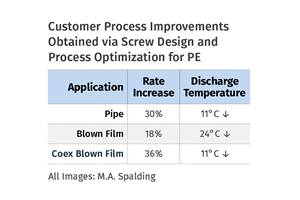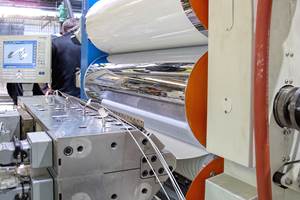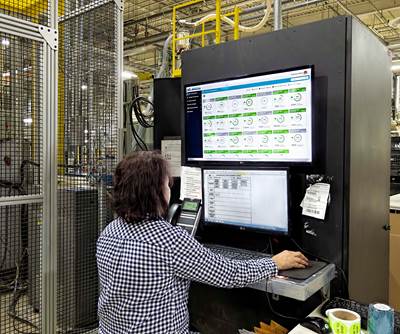The New Look in Plastic -- It's Paper!
Synthetic paper based on filled polyethylene or polypropylene film has been around for decades without causing much excitement--until recently.
Synthetic paper based on filled polyethylene or polypropylene film has been around for decades without causing much excitement--until recently. "The overall plastics industry is growing around 4% a year, but synthetic papers are growing double that, at 8%," says Mickey Mishne, president of Advanced Polymers, a consultant on printable plastics in Medina, Ohio. A long-time preserve of just a few large producers, paper-like blown and cast films are now attracting a handful of new players, as well as capacity expansions by the majors.
Still, success in this niche market doesn't come easily. Formulating is a black art, though off-the-shelf masterbatches now make it easier to get started. Also, many printers and converters are still wary of plastic's higher cost and density than cellulose paper. Thus, despite growing applications, plastic paper can still be a tough sell.
Synthetic paper targets high-priced niches like beverage labels, restaurant menus, drivers' licenses, recipe books, instruction manuals, maps, and book jackets. It folds, looks, and feels just like high-quality paper, except that it won't tear, puncture, or absorb water. It can be printed using virtually any conventional offset or gravure printing process, but only with solvent-based inks, unless it has a coating or surface that will accept water-based ink.
The first synthetic paper, called Ucar, was launched in the late 1960s by Union Carbide Corp. The market today is dominated by a handful of large, global ventures with proprietary technologies, each making a distinctive product. Yet the whole synthetic-paper market may not be much over 500 million lb/yr worldwide, estimates Jack Smith, sales manager of Hop Industries in Garfield, N.J. Hop distributes a synthetic paper recently introduced from Taiwan by Nan Ya Plastics, whose U.S. headquarters is in Houston. Smith's estimate excludes plastic products that replace paper but do not actually mimic its properties. (Examples include DuPont's Tyvek nonwoven and Van Leer's Valeron cross-laminated film.)
Spurs To Growth
Several factors are behind the recent expansions in synthetic paper and the entrance of new players and products. In Europe, synthetic paper is benefitting from the drive to replace PVC film for environmental reasons. In the U.S., synthetic paper fills more durable applications where its high cost can be justified, such as menus, maps, posters, game boards, and manuals. In Latin America, synthetic paper is actually cost competitive with cellulosic paper because of high duties on imports of the latter.
Another factor is plastic labels, which increasingly substitute for paper on beverage and juice bottles. Multi-wall paper bags and pouches are also converting to plastic-paper sacks. In Europe, some multi-wall paper sacks for pet food have switched to synthetic paper from Harrier Packaging in Peterborough, U.K., a start-up company making three-layer HDPE synthetic paper.
There are also new markets developing for paper-like films somewhere in between traditional plastic films and high-end synthetic paper. True synthetic paper tends to match all the traits of paper--like bright whiteness, opacity, water-based ink adhesion, scratch resistance, stiffness, deadfold properties, puncture strength, low coefficient of friction, and more balanced MD/TD strength. Newer paper-like films may have some but not all of these traits--e.g., they may be printable but not as stiff as paper.
An example was the conversion in the early '90s of air-courier envelopes from paper to highly filled monolayer films, which were coated to give paper whiteness and opacity, though they were still readily distinguishable from paper. More recently, Next Generation Films Inc. in Lexington, Ohio, entered this market with a three-layer coex blown film that's opaque white on one side (thanks to special fillers) and silver on the other. The product is said to have inherent cost advantages because a multi-layer structure can run a wider bubble and thinner, stronger film. Next Generation extrudes it on equipment from Hosokawa Alpine American.
What's Holding It Back
Lack of familiarity with plastic paper and reluctance to change on the part of printers, converters, and end users are still retarding growth of this market. Another problem is that synthetic paper can weigh more per 1000 sq in. than cellulose paper. "It's been a tough market to penetrate because of the film's weight," says Bill Steen Sr., v.p. of WBC Extrusion Products in Haverhill, Mass., which launched a product two and a half years ago but is still only semi-active in the market. Blown and cast-film processors are exploring multi-layer constructions to permit downgauging so as to cut weight and cost.
Everywhere except in Latin America, growth of synthetic paper is limited by price. Ten years ago, it cost four times more than paper in the U.S. Now Advanced Polymer's Mishne says the ratio is down to 3:1 and, for some products, 2:1.
Added to the higher material price is the potential for higher printing costs on plastic paper. "There may be higher waste and higher ink cost at the printing level," says Jordan Katz, president of Grafix Plastics, a film converter in Cleveland that sells to printers. His customers say printing on synthetics is slower, and the film stretches more than paper, making print registration trickier. These factors require a printer to be knowledgeable about using plastic webs. Still, Katz says, "Every time I get frustrated with synthetic paper, we get another order for it. Every year we do more and more of it."
Opacity Is In The Pits
Formulation know-how and film structure are the keys to overcoming obstacles of cost, weight, and printability. While much is proprietary in this field, several different resins and fillers are known to be used. Some paper-like films are monolayer, while others are three-layer coextrusions. Some also rely on surface coatings.
Whiteness, opacity, and printability are all achieved with the use of inorganic fillers at typical levels of 20-30% by weight. The filler itself contributes to opacity and ink adhesion, as well as impact strength and deadfold properties, though it decreases puncture strength and adds weight.
Filler particles also contribute to the phenomenon of cavitation, or formation of microscopic surface pits and voids in the film that entrap ink and add whiteness and opacity. Cavitation occurs when the heavily filled film is stretched, either through slight machine-direction orientation of cast film or through blowing a bubble in blown film. The stretch ratio in synthetic paper is slight compared with conventional biaxial orientation, but it is enough to pull the resin away from mineral particles, creating the micro-voids that scatter light and pits that hold ink. Voids can also help offset the weight of the filler.
The three biggest synthetic-paper producers all use different fillers. The Teslin Products div. of PPG Industries, Barberton, Ohio, uses Hi-Sil, an absorptive precipitated silica made by another division of PPG. Yupo Corp., a unit of Oji-Yuka Synthetic Paper Co. (a joint venture between Oji Paper and Mitsubishi Chemical), uses mica. Arjobex in the U.K., a joint venture of BP Amoco and Arjo Wiggins & Appleton Papers, Appleton, Wis., uses calcium carbonate. All use TiO2 for opacity.
Transilwrap Co. of Franklin Park, Ill., one of the smaller long-time producers of synthetic paper, uses talc-filled PP for its ProPrint product, which is used for stereo speaker cones. A white version is offered for printing. Transilwrap uses a talc/PP compound from A. Schulman Inc.
Particle size has an effect on opacity, notes filler supplier J.M. Huber Corp. Finer particles in many cases raise opacity and reduce the need for costly TiO2. Huber also notes that functionalizing the surface of the filler improves ink adhesion, impact strength, and lay flat.
Resin choice also plays a big role in synthetic paper attributes. For example, PP gives better tear resistance, while HDPE gives better stiffness for bag making. HDPE is usually required to give a sharp deadfold. Fractional-melt HDPE is one route, but HDPE is brittle unless it's blown with a high-stalk bubble. Hanmere Polythene in the U.K. has made Hankraft synthetic paper with fractional-MI HDPE for over seven years.
Newcomers to plastic paper today have the option of purchasing some formulating know-how off the shelf. A. Schulman offers a series of masterbatches called Papermatch. They were introduced in Europe eight years ago but just three years ago in the U.S. As an indication of how complex synthetic-paper formulations can be, Schulman combines six to 10 different minerals, additives, and resins in its Papermatch concentrates, which can be tailored to make paper-like films ranging from imitation white bond to brown kraft. Papermatch originally used MMW-HDPE and HMW-HDPE carriers but now also uses polymers compatible with a low-stalk bubble process. Some of Schulman's newest formulations may contain up to 20% ethylene methacrylic acid copolymer. Other recent grades are aimed at multi-layer cast films.
Coextrusion adds further formulating options. A multi-layer film allows you to blend in lower-cost resins and still achieve downgauging, says Next Generation president Dave Frecka. "I can use as many as nine different resins, including cheap butene LLDPE," he says.
Coatings are another variable for making paper-like films. Clay coatings similar to those applied to paper and typically 5 microns thick can improve tear strength, scratch resistance, and printability with aqueous inks. One early player using such coatings is Clear Cast Technologies in Ossining, N.Y., which has made Plastiprint synthetic paper since 1987. Clear Cast buys blown film and applies the coating. It uses four substrates for different types of synthetic papers: HDPE film for a rigid type, a proprietary PE blend for flexible "paper," uv-stabilized HDPE film for outdoor use, and a lower-cost PE film for indoor use.
The Big Three Expand
Historically, the big producers of synthetic paper were joint ventures of paper and resin companies. Their technologies developed separately in Europe, Japan, and the U.S. Union Carbide's technology has passed through different hands and now belongs to Arjobex. It makes Polyart synthetic paper at three plants in the U.S., U.K., and France. Arjobex doubled the capacity of its U.S. plant in Charlotte, N.C., last year and began exporting to South America, where synthetic and cellulosic paper are evenly matched in price.
Polyart is HDPE compounded with TiO2 and calcium carbonate on a twin-screw extruder that directly extrudes film through a flat die and simultaneous biaxial orientation. Rolled stock is clay coated using two doctor coating stations from Black Clawson. Polyart film is 3.2 to 12 mils thick. Recent developments have been aimed at thicker and whiter films. Arjobex is also close to introducing its first new trademarked synthetic-paper product in over 15 years. It should appear in Europe in the first quarter and in the U.S. by mid-year.
Yupo Corp. launched a filled-PP synthetic paper in Japan in the late '60s. Yupo makes it under the Kimdura name for Kimberly Clark. Two years ago, Yupo opened a U.S. plant in Chesapeake, Va., and began making the same product under its own name for different markets.
PPG's Teslin Products div. started making synthetic paper in 1987. It added a second line a few years later and is installing a third line this year. Teslin uses a mixture of PE and clear mineral oil, highly filled with precipitated silica. This mix is calendered, and then the oil is extracted after calendering, leaving a porous structure like honeycomb. Porosity makes Teslin printable with either water-based or solvent-based ink without any additional treatment because the ink soaks into the pores.
Teslin is said to be the only polyolefin-based synthetic paper that can be used in laser copying machines. Oriented films like Yupo's and Arjobex's would shrink when exposed to the 375-475 F heat used to fuse the laser toner. Teslin is now commercializing a new coated material for inkjet printing.
Porosity lowers film density, so a sheet of Teslin has a lower basis weight than other synthetics--and less stiffness, too. Porosity also gives Teslin a niche in tamper-evident films for drivers' licenses and other I.D. cards. When Teslin is laminated to another film, the second film enters the Teslin pores, so any attempt to delaminate pulls the substrate apart.
Enter New Players
In the past year or two, new firms, large and small, have gotten into synthetic paper and other films with paper-like properties for labels, tags, and the like. Four years ago, Nan Ya (a unit of Formosa Plastics in Taiwan) entered the market with a calendered, monolayer PP film filled with calcium carbonate. It's made in Taiwan and sold under several names by distributors, including Hop-Syn sold by Hop Industries.
Nan Ya has just developed another paper-like product called Dura-Lite, a three-layer structure of PP with a clay coating for extra tear strength. Dura-Lite comes in thinner gauges--2.8-7.2 mil vs. 3.2-34 mil for Hop-Syn. Both target tags, labels, and offset printing and are corona treated for enhanced printability.
Another recently developed Nan Ya synthetic paper is marketed as Polylith by Granwell Products, West Caldwell, N.J. The "G" series is calcium carbonate-filled PP oriented in the machine direction to reduce specific gravity. A newer "P" series is BOPP with TiO2 and a copolymer skin layer. Markets include prepaid phone cards and in-mold labels.
Three years ago, Mobil Chemical Films Div. (now ExxonMobil Films), Macedon, N.Y., started making synthetic-paper face stock for its Label-Lyte offset-printed beverage labels and for thermal-transfer printed, pressure-sensitive labels. The stock is coextruded OPP that's clay coated for a paper feel.
Last year, American Profol Inc. in Cedar Rapids, Iowa, launched ProPaper, a family of synthetic papers based on three-layer cast PP films. American Profol blends other resins into the PP core layer to get a softer feel and cold impact strength. The films can be used outdoors for cold-weather applications like ski tags and labels for gas bottles.
In the U.K., Harrier Packaging in Peterborough is a new firm making a three-layer coextruded blown film using a fractional-melt HDPE core and heavily filled HDPE surface layers to give "PaperFeel" its paper-like stiffness and deadfold. The material is blown on a three-layer coex line from Battenfeld Gloucester similar to lines used for heavy-duty sacks. Film is converted on a standard SOS (self-opening sack) bag machine.
Related Content
How Polymer Melts in Single-Screw Extruders
Understanding how polymer melts in a single-screw extruder could help you optimize your screw design to eliminate defect-causing solid polymer fragments.
Read MoreHow Screw Design Can Boost Output of Single-Screw Extruders
Optimizing screw design for a lower discharge temperature has been shown to significantly increase output rate.
Read MoreRoll Cooling: Understand the Three Heat-Transfer Processes
Designing cooling rolls is complex, tedious and requires a lot of inputs. Getting it wrong may have a dramatic impact on productivity.
Read MoreWhy Are There No 'Universal' Screws for All Polymers?
There’s a simple answer: Because all plastics are not the same.
Read MoreRead Next
People 4.0 – How to Get Buy-In from Your Staff for Industry 4.0 Systems
Implementing a production monitoring system as the foundation of a ‘smart factory’ is about integrating people with new technology as much as it is about integrating machines and computers. Here are tips from a company that has gone through the process.
Read MoreMaking the Circular Economy a Reality
Driven by brand owner demands and new worldwide legislation, the entire supply chain is working toward the shift to circularity, with some evidence the circular economy has already begun.
Read MoreBeyond Prototypes: 8 Ways the Plastics Industry Is Using 3D Printing
Plastics processors are finding applications for 3D printing around the plant and across the supply chain. Here are 8 examples to look for at NPE2024.
Read More














